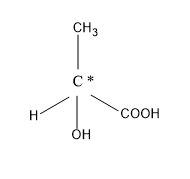
Is
Answer
406.8k+ views
Hint: Optical activity of a compound is defined as the ability of a substance or compound to rotate the plane polarized light. When the plane polarized light passes through the solution of the substance, it can rotate the plane polarized light either in the clockwise direction or in the anti-clockwise direction.
Complete answer:
Optical activity of the compound is the function of the presence or the absence of the chiral atom in it.
So, the optically active compound can be in the dextrorotatory form and the Laevorotatory form.
So, let’s see the structure of the

As we can see from the above figure that the
So, we can say it is very clear from the above discussion that the
So the answer to our question is –: yes
Note:
So, let’s see what is the chiral atom – so chiral atom is the atom which has all four different groups bonded to it. Only those substances are optically active, which have a chiral centre. Generally a chiral centre is denoted by the ‘asterisk sign’. This is an important aspect in determining structure.
Complete answer:
Optical activity of the compound is the function of the presence or the absence of the chiral atom in it.
So, the optically active compound can be in the dextrorotatory form and the Laevorotatory form.
So, let’s see the structure of the

As we can see from the above figure that the
So, we can say it is very clear from the above discussion that the
So the answer to our question is –: yes
Note:
So, let’s see what is the chiral atom – so chiral atom is the atom which has all four different groups bonded to it. Only those substances are optically active, which have a chiral centre. Generally a chiral centre is denoted by the ‘asterisk sign’. This is an important aspect in determining structure.
Latest Vedantu courses for you
Grade 8 | CBSE | SCHOOL | English
Vedantu 8 CBSE Pro Course - (2025-26)
School Full course for CBSE students
₹45,300 per year
Recently Updated Pages
Master Class 9 General Knowledge: Engaging Questions & Answers for Success

Master Class 9 English: Engaging Questions & Answers for Success

Master Class 9 Science: Engaging Questions & Answers for Success

Master Class 9 Social Science: Engaging Questions & Answers for Success

Master Class 9 Maths: Engaging Questions & Answers for Success

Class 9 Question and Answer - Your Ultimate Solutions Guide

Trending doubts
State and prove Bernoullis theorem class 11 physics CBSE

Who built the Grand Trunk Road AChandragupta Maurya class 11 social science CBSE

1 ton equals to A 100 kg B 1000 kg C 10 kg D 10000 class 11 physics CBSE

State the laws of reflection of light

One Metric ton is equal to kg A 10000 B 1000 C 100 class 11 physics CBSE

Difference Between Prokaryotic Cells and Eukaryotic Cells




